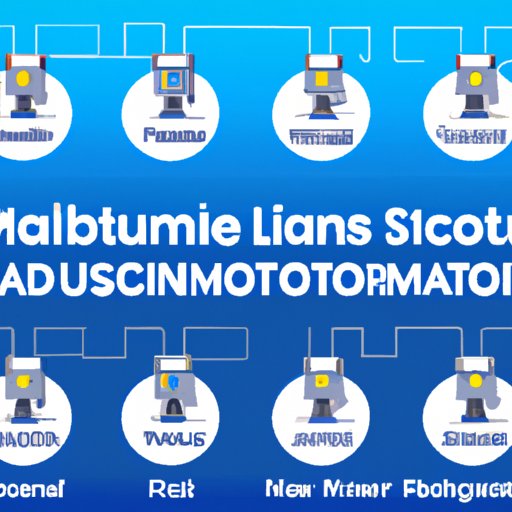Introduction
In today’s modern business world, automation has become increasingly important for organizations that want to stay competitive and efficient. Automation is the process of using technology to streamline and simplify repetitive tasks, freeing up employees to focus on more complex and valuable tasks. By automating work, businesses can save time and money while increasing efficiency and productivity. In this article, we’ll explore how to automate work, including what automation is, identifying areas of work to automate, setting up automation workflows, best practices for automating work, and examples of companies who have successfully implemented automation.
What is Automation?
Automation is the use of technology to automate manual tasks, such as customer service, data entry, and other administrative processes. Automation can be used in any area of a business, from sales and marketing to finance and operations. Automation can also be used to improve customer experience by providing faster response times and more accurate information. Automation tools, such as software robots or bots, are programmed to execute specific tasks, such as responding to emails, processing orders, and generating reports.
Benefits of Automating Work
There are numerous benefits to automating work. Automation can increase efficiency and accuracy by reducing human error and eliminating manual processes. It can also lead to cost savings, since automated systems require fewer resources than manual processes. Additionally, automation can free up employees to focus on more meaningful tasks and reduce employee burnout. According to a study by McKinsey & Company, “up to 45 percent of the activities individuals are paid to perform can be automated by adapting currently demonstrated technologies.”

Identifying Areas of Work to Automate
When it comes to automating work, it’s important to identify which tasks should be automated and which should remain manual. Generally, tasks that are repetitive, time-consuming, and low-value are good candidates for automation. Common tasks that can be automated include customer service, data entry, scheduling, invoicing, and reporting.

Assessing Which Tasks Should Be Automated
Before automating any task, it’s important to assess the potential impact of automation. Factors to consider include the complexity of the task, the amount of time it takes to complete, and the value it adds to the business. Additionally, it’s important to consider the potential risks associated with automation, such as data security, compliance, and legal issues. Once you’ve identified the tasks that should be automated, you can move on to the next step: setting up automation workflows.
Setting Up Automation Workflows
Once you’ve identified the tasks to be automated, the next step is to set up automation workflows. An automation workflow is a series of steps that are executed automatically to complete a task. Automation workflows can be set up using various tools and services, such as software robots or bots, cloud-based automation platforms, and custom scripts. When choosing an automation tool, consider factors such as cost, ease of use, scalability, and security.
Step-by-Step Guide to Setting Up Automation Workflows
1. Identify the tasks to be automated.
2. Choose the right automation tools.
3. Set up the automation workflow.
4. Test and optimize the automation workflow.
5. Monitor and adjust the automation workflow as needed.
Best Practices for Automating Work
When automating work, it’s important to follow best practices to ensure success. Here are some of the best practices to keep in mind:
Establishing Clear Goals and Objectives: Before setting up an automation workflow, it’s important to define clear goals and objectives for the automation project. This will help ensure that the automation workflow is set up correctly and that it meets the needs of the business.
Setting Reasonable Expectations: Automation can provide significant benefits, but it’s important to set realistic expectations for the automation project. Automation won’t solve all of your problems, so it’s important to understand the limitations of automation.
Planning for Scalability: As your business grows, it’s important to plan for scalability by selecting automation tools that can easily scale with your business. This will help ensure that your automation workflows can handle the increased workload.
Testing Automation Workflows: Before rolling out an automation workflow, it’s important to test it to ensure that it works as expected. This will help ensure that the automation workflow performs as intended and that it meets the needs of the business.

Examples of Companies Who Have Successfully Implemented Automation
Automation has been successfully implemented by many companies, both large and small. Here are a few examples of companies who have successfully implemented automation:
Uber: Uber uses automation to manage its fleet of drivers and vehicles. The company’s system automatically matches drivers with riders, calculates fares, and dispatches drivers to pick up riders.
Netflix: Netflix uses automation to personalize its content recommendations. The company’s system automatically analyzes user data to determine which movies and TV shows are likely to be of interest to each user.
Amazon: Amazon uses automation to manage its massive ecommerce operation. The company’s system automatically processes orders, manages inventory, and recommends products to customers.
Case Studies of Automation in Action
To get a better understanding of how automation can benefit businesses, let’s take a look at a couple of case studies.
Vodafone: Vodafone, a telecom company, used automation to streamline its customer service process. The company implemented an automation system that could answer customer inquiries in real time, resulting in a 20% reduction in the time it took to respond to customer inquiries.
UPS: UPS, a logistics company, used automation to optimize its package delivery process. The company implemented an automated system that could track packages in real time, resulting in a 10% reduction in delivery times.
Common Challenges Encountered When Automating Work
While there are many benefits to automating work, there are also some challenges that businesses may encounter. Common challenges include difficulty integrating automation into existing systems, resistance from employees, and security and compliance issues. It’s important to be aware of these potential issues and develop strategies to address them.
Conclusion
Automating work can help businesses save time and money while increasing efficiency. By following the steps outlined in this article, businesses can identify areas of work to automate, set up automation workflows, and implement best practices for automating work. Additionally, by taking a look at case studies of companies who have successfully implemented automation, businesses can gain insight into the potential benefits and challenges of automating work. With the right approach, businesses can reap the rewards of automation and stay competitive in today’s modern business world.
(Note: Is this article not meeting your expectations? Do you have knowledge or insights to share? Unlock new opportunities and expand your reach by joining our authors team. Click Registration to join us and share your expertise with our readers.)
